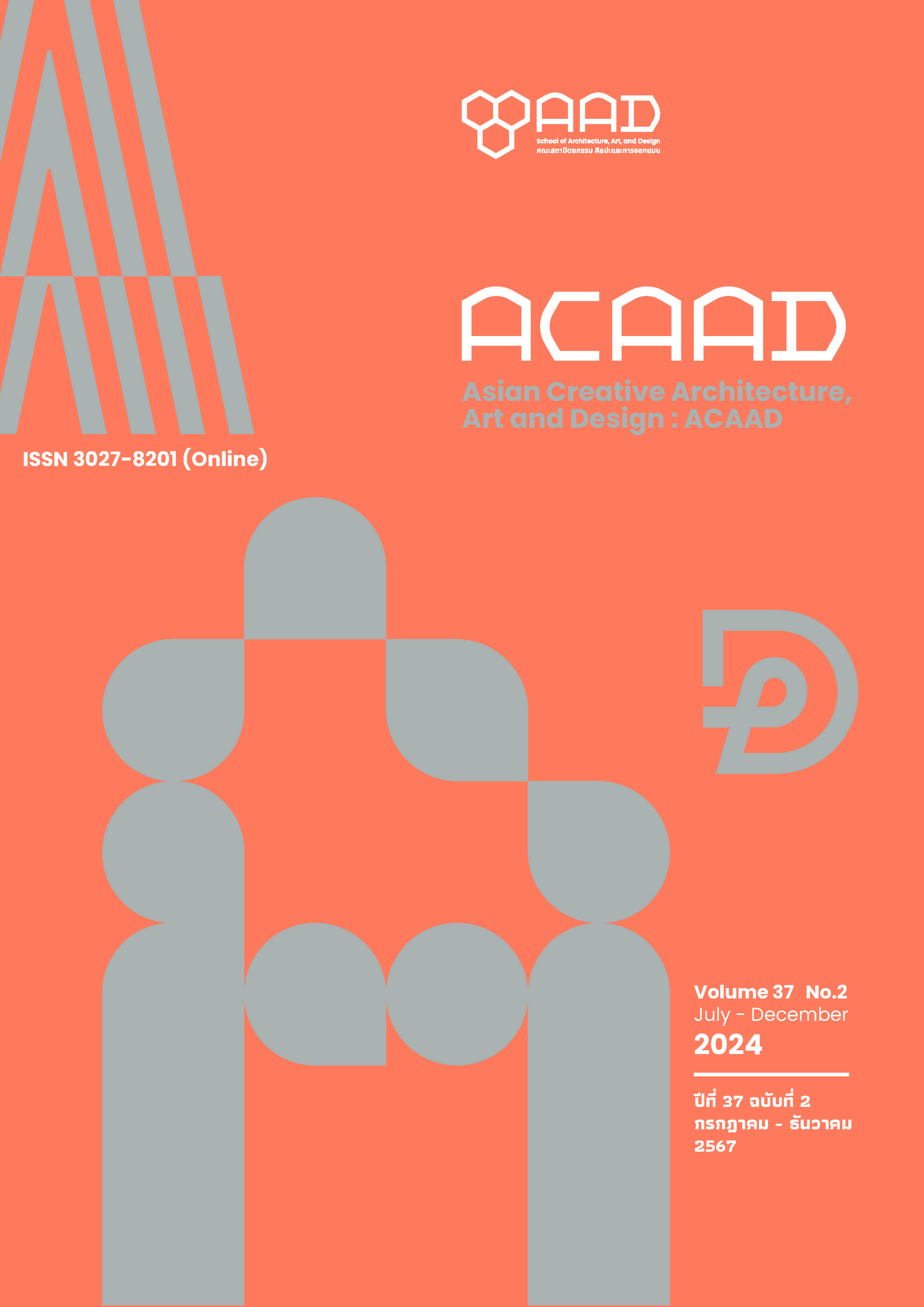ข้อเสนอแนะกรอบการพิจารณามรดกอุตสาหกรรมในประเทศไทยจากการวิพากษ์แนวคิดการให้คุณค่า
Main Article Content
บทคัดย่อ
ปัจจุบันมีทรัพย์สินที่ได้รับการขึ้นทะเบียนมรดกอุตสาหกรรมมาจากประเทศที่ไม่ผ่านการปฏิวัติอุตสาหกรรม เพียง 8 แห่ง จากทั้งหมด 50 แห่ง และทั้ง 8 แห่ง อยู่ในประเทศอาณานิคมประเทศของชาวตะวันตก จากการศึกษาการระบุคุณค่าที่โดดเด่นเป็นสากล และแนวคิดการอนุรักษ์มรดกอุตสาหกรรมในเชิงพัฒนาการพบว่า เริ่มจากภาคพื้นยุโรป และกระจายสู่ภูมิภาคอื่น ๆ โดยยังมีการอนุรักษ์บนแนวคิดแบบยุโรปเป็นศูนย์กลาง (Eurocentric) คือ ยังไม่คลายออกจากการพิจารณาถึงการปฏิวัติอุตสาหกรรม และการเข้าไปจัดการให้เกิดอุตสาหกรรมและทรัพยากรในภูมิภาคอื่นของชาวยุโรป และประเทศที่ผ่านการปฏิวัติอุตสาหกรรม ดังนั้นประเทศในภูมิภาคต่าง ๆ ยังต้องทำความเข้าใจในบริบทเฉพาะของตนเอง เพื่อพิจารณามรดกอุตสาหกรรมของตนเองให้ได้ งานวิจัยฉบับนี้มีวัตถุประสงค์เพื่อเสนอแนะกรอบการพิจารณามรดกอุตสาหกรรม ในประเทศไทย จากการศึกษาเกณฑ์การพิจารณามรดกอุตสาหกรรมในระดับสากล เก็บข้อมูลเพิ่มเติมจากการสัมภาษณ์เชิงลึกมีส่วนได้ส่วนเสียในพื้นที่ศึกษา นำมาวิพากษ์ในบริบทของประวัติศาสตร์ไทยในช่วงเวลาที่ได้รับผลกระทบจากการปฏิวัติอุตสาหกรรม (Industrial Revolution) ลัทธิล่าอาณานิคมตะวันตก (Colonialism) และการทำให้เป็นสมัยใหม่แบบตะวันตก (Modernization) โดยวิเคราะห์ข้อมูลตามตัวแปร 3 ตัวแปร ได้แก่ เกณฑ์การพิจารณามรดกอุตสาหกรรมระดับสากล มุมมองทางประวัติศาสตร์ และคำจำกัดความคุณค่ามรดก
ผลการวิจัยพบว่า ระดับความเชื่อมโยงระหว่างทรัพย์สินใด ๆ กับบริบททางสังคมเป็นตัวกำหนดระดับคุณค่า ความสำคัญของทรัพย์สินนั้น การศึกษามุมมองทางประวัติศาสตร์ต่อฉากทัศน์การเปลี่ยนแปลงภูมิทัศน์ด้านต่าง ๆ ของไทย 2 แบบ แบบแรก คือ การอยู่ในสถานะกึ่งเมืองขึ้น แบบที่สอง คือ การก่อรูปรัฐสมัยใหม่ของสยามโดยมีกรุงเทพฯ เป็นศูนย์กลาง สร้างภาพที่กว้างขึ้นของระดับความเชื่อมโยงกับบริบททางสังคมของทรัพย์สินทางอุตสาหกรรมในไทย และคุณค่า
Article Details

This work is licensed under a Creative Commons Attribution-NonCommercial-NoDerivatives 4.0 International License.
This work is licensed under a Creative Commons Attribution-NonCommercial-ShareAlike 4.0 International License.
Copyright Transfer Statement
The copyright of this article is transferred to Journal of The Faculty of Architecture King Mongkut's Institute of Technology Ladkrabang with effect if and when the article is accepted for publication. The copyright transfer covers the exclusive right to reproduce and distribute the article, including reprints, translations, photographic reproductions, electronic form (offline, online) or any other reproductions of similar nature.
The author warrants that this contribution is original and that he/she has full power to make this grant. The author signs for and accepts responsibility for releasing this material on behalf of any and all co-authors.
References
Aphonrnsuvan, T. (2020). On Bourgeoisie. Sommadhi. (in Thai)
Avrami, E., & Mason, R. (2019). Mapping the Issue of Values. In E. Avrami, S. Macdonald, R. Mason, & D. Myers, Values in Heritage Management (pp. 9–33). The Getty Conservation Institute. https://www.getty.edu/publications/resources/virtuallibrary/9781606066195.pdf
Avrami, E., Macdonald, S., Mason, R., & Myers, D. (2019). Introduction. In E. Avrami, S. Macdonald, R. Mason, & D. Myers, Values in Heritage Management (pp. 1–8). The Getty Conservation Institute. https://www.getty.edu/publications/resources/virtuallibrary/9781606066195.pdf
Baker, C., & Phongpaichit, P. (2014). A History of Thailand (3rd ed.). Cambridge University Press. https://doi.org/10.1017/cbo9781139656993
Bergeron, L. (2008). Industrial Heritage – and beyond ?. In J. Douet (Eds.), The ten years of the TICCIH bulletin: THE INTERNATIONAL COMMITTEE FOR THE CONSERVATION OF THE INDUSTRIAL HERITAGE (p. 4). Spring Number 40. https://ticcih.org/wp-content/uploads/2013/04/1209479209_b40.pdf
Bole, D. (2021). ‘What is industrial culture anyway?’ Theoretical framing of the concept in economic geography. Geography Compass, 15(11), 1-16. https://doi.org/10.1111/gec3.12595
Britannica. (2023). Industrial Revolution | Definition, History, Dates, Summary, & Facts | Britannica. Encyclopedia Britannica - Isomerism.
Cassanelles, E. (2008). The ten years of the TICCIH bulletin. In J. Douet (Eds.), The ten years of the TICCIH bulletin: THE INTERNATIONAL COMMITTEE FOR THE CONSERVATION OF THE INDUSTRIAL HERITAGE (p. 4). Spring Number 40. https://ticcih.org/wp-content/uploads/2013/04/1209479209_b40.pdf
Chungsiriarak, S. (2016). The Concepts of Architectural Conservation From the 18" to the End of the 20° Century: From Sentiment and Faith to the Shared Heritage of Humankind. NAJUA: Architecture, Design and Built Environment Arch SU Journal, 21, 71–82. https://so04.tci-thaijo.org/index.php/NAJUA-Arch/article/view/45310 (in Thai)
Davies, J. J. (2008). Industrial heritage buildings and sites in Thailand from the 1850’s-1950’s: the relationship of the architecture, communities and narratives, [Master’s thesis]. Silpakorn University.
Mason, R. (2002). Assessing Values in Conservation Planning: Methodological Issues and Choices. In M. De la Torre (Ed.), Assessing the Values of Cultural Heritage (pp. 5–30). The Getty Conservation Institute. http://hdl.handle.net/10020/gci_pubs/values_cultural_heritage
Feinstein, Y. (n.d.). nation-state. Encyclopedia Britannica.
Hall, S., & Gieben, B. (1992). Formations of modernity. Polity Press.
Harfst, J., Wust, A., & Nadler, R. (2018). Conceptualizing industrial culture. GeoScape, 12(1), 1-9. https://doi.org/10.2478/geosc-2018-0001
Hoffman, P. T. (2015). Why did Europe conquer the world?. Princeton University Press. https://doi.org/10.2307/j.ctvc778hd
Iqbal, N., Akbar, S.H., Van Cleempoel, K. (2022). Identification of Industrial Heritage and a Theoretical Framework for an Industrial Heritage Inventory System in Pakistan. Sustainability, 14(10), 5797. https://doi.org/10.3390/su14105797
Jokilehto, J. (2006). World Heritage: Defining the Outstanding Universal Value. City & Time, 2(2). http://www.ct.ceci-br.org
Logan, W. (2001). Globalizing Heritage: World Heritage as a Manifestation of Modernism and Challenges from the Periphery. 20th Century Heritage: Our Recent Cultural Legacy. the Australia ICOMOS National Conference 2001. Adelaide, the University of Adelaide, Australia.
McLennan, G., Held, D., & Hall, S. (1984). The Idea of the modern state. Open University Press.
Mead, K. K. (2013). The Internationalization of Capitalism and Neoliberalism. Journal of Social Science, 43(20), 7–43. https://digital.car.chula.ac.th/cujss/vol43/iss2/2 (in Thai)
Natsupa, C. (1996). Comparative history of the industrial revolution. Sangsan. (in Thai)
Natsupa, C. (2014). Modernity and the community concept. Sangsan. (in Thai)
Natsupa, C., & Manarangsan, S. (1984). Thai Economic System 1851-1910. Thammasat University Press. (in Thai)
Phongpaichit, P., & Baker, C. (2023). Thailand Economy and Politics (P. Phongpaichit, Ed.; 6th ed.) Silkworm Books. (in Thai)
Prasanseth, S. (2013). Evolution of The Thai Economic System Over the Past 200 Years. Burapha Journal of Political Economy, 1(1), 23–49. https://so01.tci-thaijo.org/index.php/pegbuu/article/view/199677 (in Thai)
Rajchagool, C. (2021). The Rise and Fall of the Thai Absolute Monarchy. Aan. (in Thai)
Rautenberg, M. (2012). Industrial heritage, regeneration of cities and public policies in the 1990s: Elements of a French/British comparison. International Journal of Heritage Studies, 18(5), 513-525 https://doi.org/10.1080/13527258.2011.637945
Sampatchalit, S. S. (2008). The origin of the capitalist class in Thailand (1855-1910). Sangsan. (in Thai)
Suteerattanapirom, K. (2006). The Development of Concept and Practice of Ancient Monuments Conservation in Thailand. Damrong Journal, 5(2), 133–150. https://so01.tci-thaijo.org/index.php/damrong/article/view/20996 (in Thai)
The International Committee for the Conservation of the Industrial Heritage. (2003, July 10-July 17). The Nizhny Tagil Charter for the Industrial Heritage [Paper presentation]. The triennial National Assembly of TICCIH, Moscow. https://ticcih.org/wp-content/uploads/2013/04/NTagilCharter.pdf

